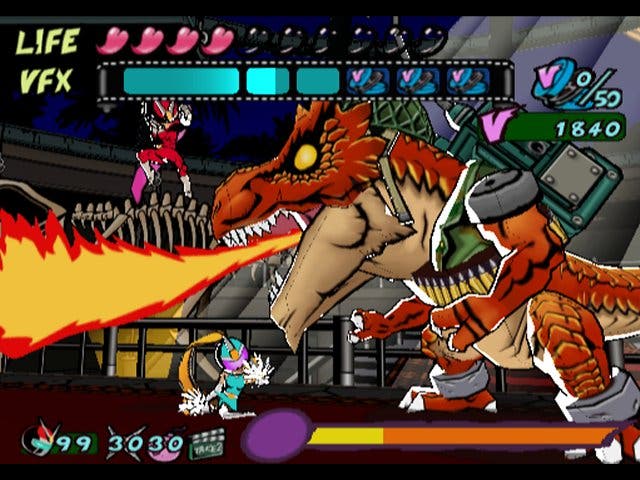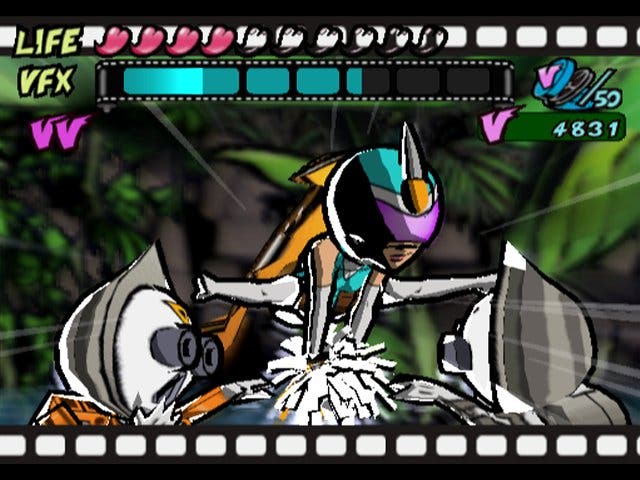Viewtiful Joe 2
Return of the Mach.
"This is for kids, right?" the man in the suit asked, cautiously thumbing the analogue stick like he was sifting through stapled profit forecasts. The man in the Capcom shirt on his shoulder exhaled at length. "It's actually not. It's more of a hard core thing. It's kind of deceptive," he offered in response. "It's what the people who were kids ten years ago are playing these days. It's a lot harder." There was a pause. "But it looks like a cartoon!" the suit retorted, his eyes shifting nervously to and fro, abandoning the screen every so often as if his boss might pop out of a thumping speaker ten feet away and demand an explanation. We felt his guide's eyes roll before we even saw them, but we knew how he felt.
Granted, the man in the suit was controlling - well, attempting to control - a teenage girl with pom-poms and stockings as she danced provocatively back and forward on the spot, occasionally leaping into the air and firing a gun manically in every direction - and he didn't get it. But then Viewtiful Joe 2 wasn't made for him, and the man in the Capcom shirt - his exhaustion now plainly visible as he shifted his weight from foot to foot and glanced impatiently in the direction of a door marked "Staff" - clearly hoped to be rid of this tourist before he had to outline how Pikachu was a Nintendo character and Capcom rolled its own. Fortunately, in the meantime the suit's patience had quietly worn the thinnest, and he turned, thanked the T-shirt for its time, and strolled off in the direction of the nearest bikini. A couple of 20 year-olds with pamphlet-laden handout bags took his place. They needed no supervision.
Henshin-a-go-away-and-play-something-else

Around here we often point out that trade shows are terrible places to build an opinion of a game, but in truth Viewtiful Joe is a difficult game to judge with less than a few spare hours to do so. Outwardly childish and frantic, it's only after careful observation that you can crack the two-dimensional Saturday morning exterior and start to appreciate the cold and calculating mechanics that lie beneath. It is, for want of a better pun, simply not a game that the Average Joe is likely to understand. They will pick it up, they will try to see past the oft-garish colour scheme and the whimsical graphics, they will make it past a couple of levels and then they will die, and upon returning to the start they won't be all that inclined to continue. It's something that producer Atsushi Inaba knows only too well - having famously implored journalists to help him sell the game at a press event last year when VJ fever was in its infancy.
But amongst those who have penetrated the childish veneer and cracked the complex system that throbs at its heart, it's ultimately largely thanks to this bizarre juxtaposition of garish juvenility and precise gameplay that it manages to endure. It's a system that demands style and flair to succeed, and part of the attraction is that the player's own carefully marshalled digits are dancing their way through these sorts of gorgeously eclectic and incomprehensible sights and sounds, flapping at obscure and unlikely but wonderfully vibrant enemies and sending them careening into choppers and each other in slow motion before dashing past at screen-tearing speeds. It's one of the main reasons that Viewtiful Joe sat so well with hardcore Capcom followers. It's also one of the main reasons that Atsushi Inaba, director Masaaki Yamada and the team at Clover Studios - largely comprised of ex-Team Viewtiful folk - have chosen to retain so much of the original in crafting this quick-sharp follow-up.
Action Replay

Indeed, it's clear at this stage - the trade show snapshot issue notwithstanding - that much of what will make Viewtiful Joe 2 good was already in the blueprint when production began on the first title. Joe can still duck below and leap above attacks when prompted, before shifting into slow motion and lining up dazzling combination responses; the fabled VFX powers allow him to slow down, speed up, zoom and exercise other curious abilities as long as his VFX meter holds up; and part of the challenge is figuring out how to combine the powers and combat to make it past eccentric puzzles. And, as before, another part is simply finding a way to remain vertical in the face of an increasing onslaught, where even the enemies become puzzles that require lateral thinking and a full and working knowledge of Joe's arsenal to overcome.
The graphics, too, retain much of the character of the original. The opening prehistoric level has pterodactyls soaring through the sky on a montage of scribbled jungle shapes in front of the spectre of palm trees on the horizon, and translucent shadows that scroll slightly faster in the foreground to give the impression of depth; as Joe bounds along, his cape flapping in the imaginary breeze like a flag on a race car, and the screen occasionally hums to life and draws closer to him as he slows down to take advantage of his precognitive ability to dodge punches and bullets.
But what Clover has done with this sequel is to steadily augment, both in terms of Joe's abilities, and the game at large. Joe now benefits from a Replay VFX power, for example, which allows him to record a few moments of real-time action and then replay them to multiply bonuses and attacking effects. And like the rest of the game's original ideas, each of the sequel's innovations is woven into virtually every area - health supplies can be tripled, damage inflicted (and endured) can be tripled, and Joe can even use Replay to influence the outcome of puzzles. In one area, a punching block with three lights on it clearly controls the next door, and the only way Joe can hit it thrice simultaneously - at least in the eyes of the physics of the thing - is to Replay his punching action at just the right moment.
If you want something doing...

On a grander scale, the other obvious addition is Joe's girlfriend Silvia, alluded to during our brush with the suit earlier, who drops her bespectacled victim routine in favour of joining our hero on his mission to prevent the evil Gedow Empire bridging the gap between reality and Movie Land. Cheerleader-like in looks now and ballerina-esque in her movements, she kicks, flips, splits and generally hurls herself around, thrusting pom-poms into the eyes of enemies and - crucially - using a projectile gun weapon to add another dimension to the combat. In practice this aids lengthier combos considerably, allowing practised players to cap off an attack with an explosive final salvo to reap some extra rewards.
Another interesting aspect of her inclusion (apart from the fact that you can now play through the single-player campaign as either her or Joe) is that the dazzling duo can actually co-operate, in a sort of tag-team sense that sees Joe lining up an enemy and Silvia knocking him down. We've yet to experience the full extent of their collaboration, but if it's on a par with the rest then it ought to be yet another reason for fans of the original to take notice - and certainly backs up Inaba's claims that the game is both longer to finish and brimming with even more content.
It's also pleasing to see that in adding these new abilities and ideas after the fact - key though many of them are - Clover has managed to strike a balance, at least in the levels we've played, between old and new. Some of the puzzles are simply vintage VJ - one in particular that springs to mind involves a switch and a volcano in the background. At normal speed, the volcano chugs away and occasionally a rock on top jumps up in the air to release the built up pressure. After a while though, you realise that slowing down time actually stores up even more pressure, until there's just enough to send the rock hurtling through the air and into the foreground - where it lands on a switch at just the right point to open a door barring your progress.
The game's surreal streak hasn't lessened any either - whether it's metal triceratops chasing into the foreground on conveyor belts as you speed past, or uppercutting a plug into a socket and then using Mach speed to turn a nearby hamster wheel just fast enough to power the door mechanism attached to it. Although many of the ideas present in the VJ2 demo clearly could just as easily have appeared in the original, we're tempted to say that they're just as enjoyable to complete, and that the overall result of the time put in so far is a game that resembles the original in lots of ways, but rather than simply mimicking it physically actually remains engaging and enjoyable in the same ways instead.
Suits us
On a surface level then, it remains just as dotty and incomprehensible as ever to the man in the suit, and it's not destined to convert anybody who found themselves ill-equipped to deal with its searing difficulty. On the other hand, fans of the original are likely to have just as much fun exploring its depths, and although we're mindful that we've so much yet to see (not least of all Joe's new Six Machine capabilities in action, like the guns and the submarine to name two), we're also confident that when we do see it we'll be glad we kept the faith. Cross your fingers and whack the Replay button for good luck, and then Mach speed to next year for the verdict.
Viewtiful Joe 2 is due out on PS2 and GameCube in spring 2005.

